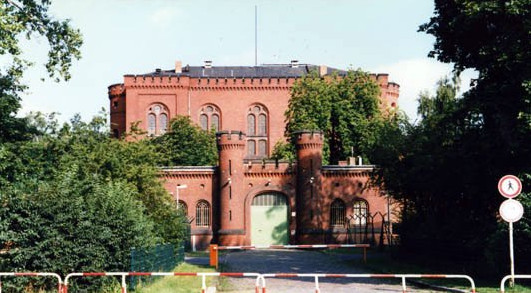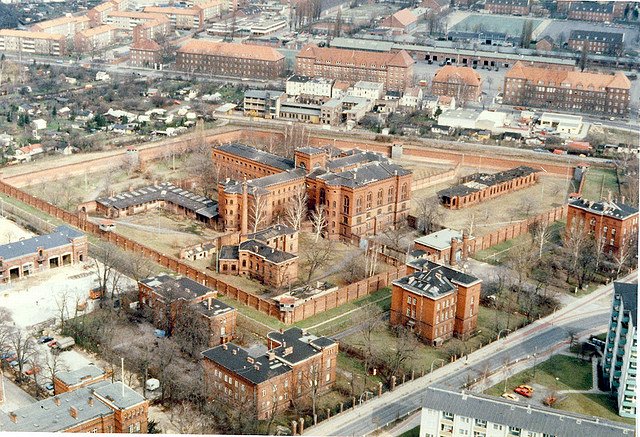Spandau Prison
History

Spandau Prison was built in 1876 on Wilhelmstraße. It initially served as a military detention center. From 1919 it was also used for civilian inmates. It held up to 600 inmates at that time.
In the aftermath of the Reichstag fire of 1933, opponents of Hitler and journalists such as Egon Kisch and Carl von Ossietzky were held there in so-called protective custody. Spandau Prison became a sort of predecessor of the Nazi concentration camps. While it was formally operated by the Prussian Ministry of Justice, the Gestapo tortured and abused its inmates, as Egon Erwin Kisch recalls in his memories of Spandau Prison. By the end of 1933 the first Nazi concentration camps had been erected (at Dachau, Osthofen, Oranienburg, Sonnenburg, Lichtenburg and the marshland camps around Esterwegen); all remaining prisoners who had been held in so-called protective custody in state prisons were transferred to these concentration camps.
After World War II it was operated by the Four-Power Authorities to house the Nazi war criminals sentenced to imprisonment at the Nuremberg Trials.
Only seven prisoners were finally imprisoned there. Arriving from Nuremberg on 18 July 1947, they were: Konstantin von Neurath, Erich Raeder, Karl Dönitz, Walther Funk, Albert Speer, Baldur von Schirach, and Rudolf Hess.
Of the seven, three were released after serving their full sentences, while three others (including Raeder and Funk, who were given life sentences) were released earlier due to ill health. Between 1966 and 1987, Rudolf Hess was the only inmate in the prison and his only companion was the warden, Eugene K. Bird, who became a close friend. Bird wrote a book about Hess's imprisonment titled The Loneliest Man in the World.
Spandau was one of only two Four-Power organizations to continue to operate after the breakdown of the Allied Control Council; the other was the Berlin Air Safety Center. The four occupying powers of Berlin alternated control of the prison on a monthly basis, each having the responsibility for a total of three months out of the year. Observing the Four-Power flags that flew at the Allied Control Authority building could determine who controlled the prison.
The prison was demolished in 1987, largely to prevent it from becoming a Neo-Nazi shrine, after the death of its final remaining prisoner, Rudolf Hess, who had been the prison's sole occupant after the release of Speer and von Schirach in 1966. To further ensure its erasure, the site was made into a parking facility and a NAAFI shopping center, named The Britannia Centre Spandau and nicknamed Hessco's after the well known British supermarket chain, Tesco. All materials from the demolished prison were ground to powder and dispersed in the North Sea or buried at the former RAF Gatow airbase. In 2013 a single brick turned up on the BBC programme Antiques Roadshow.
As of 2006, a Kaiser's Supermarket, ALDI, and a Media Markt consumer electronics store occupied the former prison grounds. In late 2008, Media Markt left the main shopping complex. The space lies now abandoned. In 2011 the new owner, a development company applied for permission to demolish the cinema complex of the Britannia Centre, which is used by ALDI. The contracts for both, the cinema complex and the shopping complex, with Kaiser's, were terminated.
The Prison
The prison, initially designed for a population in the hundreds, was an old brick building enclosed by one wall 4.5 m (15 ft.) high, another of 9 m (30 ft.), a 3 m (10 ft.) high wall topped with electrified wire, followed by a wall of barbed wire. In addition, some of the sixty soldiers on guard duty manned 6 machine-gun armed guard’s towers 24 hours a day. Due to the number of cells available, an empty cell was left between the prisoners' cells, to avoid the possibility of prisoners' communicating in Morse code. Other remaining cells in the wing were designated for other purposes, with one being used for the prison library and another for a chapel. The cells were approximately 3 metres (10 ft.) long by 2.7 metres (9 ft.) wide and 4 metres (13 ft.) high.
The Prison Garden
The highlight of the prison, from the inmates' perspective, was the garden. Very spacious given the small number of prisoners using it, the garden space was initially divided into small personal plots that were used by each prisoner in various ways, usually for the growing of vegetables. Dönitz favoured growing beans, Funk tomatoes and Speer daisies; although, the Soviet director subsequently banned flowers for a time. By regulation, all of the produce was to be put toward use in the prison kitchen, but prisoners and guards alike often skirted this rule and indulged in the garden's offerings. As prison regulations slackened and as prisoners became either apathetic or too ill to maintain their plots, the garden was consolidated into one large workable area. This suited the former architect Speer, who, being one of the youngest and liveliest of the inmates, later took up the task of refashioning the entire plot of land into a large complex garden, complete with paths, rock gardens and floral displays. On days without access to the garden, for instance when it was raining, the prisoners occupied their time making envelopes together in the main corridor.
